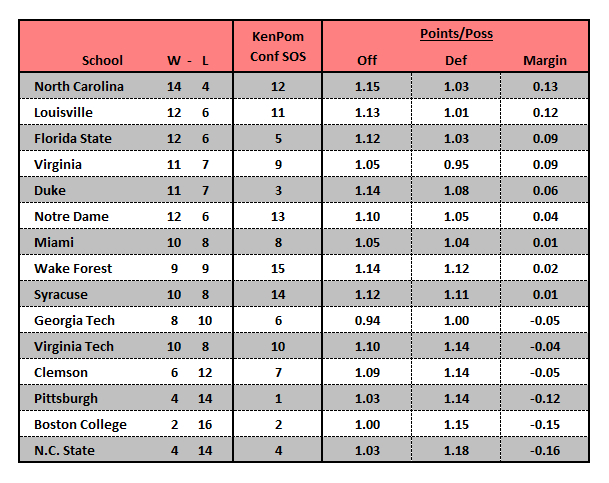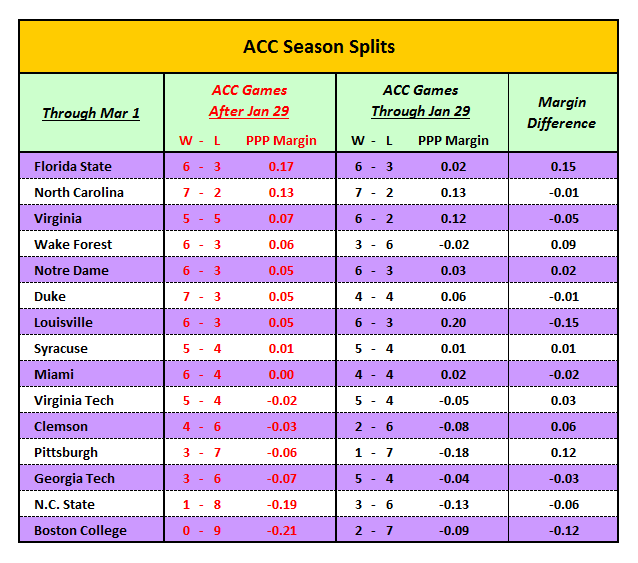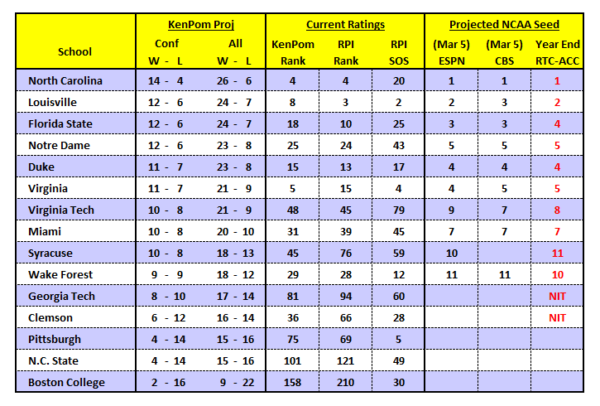Inside the ACC Numbers: Volume VIII – Final Edition
Posted by Brad Jenkins (@bradjenk) on March 7th, 2017Here is the final edition of our weekly review of the current ACC standings and team performances where we focus on which teams are playing better or worse than their records indicate. Each week we delve into advanced metrics to reveal a few interesting teams, player statistics and trends. With the regular season now complete, we will look at which ACC teams performed better in the second half of league play and how that may impact the upcoming ACC Tournament. Finally, we forecast how the final ACC standings may look given current efficiency margins and what that means for each team’s postseason aspirations.
Note: All data is current for games played through Saturday, March 4.
Current Standings
North Carolina finished with an impressive two-game lead in the standings to edge out Louisville with the league’s top efficiency margin. Since the Cardinals finished as the #4 seed for this week’s ACC Tournament in Brooklyn, the two best teams in the conference landed on the same side of the bracket. The Tar Heels finish with the league’s top offense for the first time since 2009 — incidentally the last time North Carolina won the National Championship. This year, Roy Williams’ club used an outstanding offensive rebounding rate (42.5%) to overcome a modest shooting year — the Heels finished 10th in the league in effective field goal percentage (51.7%). Virginia reclaimed its status as the ACC’s best defensive squad, as Tony Bennett‘s teams have now finished as one of the ACC’s two best defenses in each of the last six seasons. Virginia’s pack line defense led the league in forcing turnovers (20.1%) and finished third in opponents’ effective field goal percentage (48.5%).
Advanced Statistic of the Week: Comparing First and Second Halves of ACC Play
The above table splits the conference season into two parts and compares how each ACC team performed during both halves of the schedule. A number of interesting situations are revealed. North Carolina was amazingly consistent all year — posting identical records and efficiency margins in each half of its ACC schedule. Florida State and Louisville experienced opposite halves in points per possession (PPP) margin despite posting the same record in each. A blowout win distorts the figures in both cases — the Cardinals’ 55-point pounding of Pittsburgh happened in the first half of ACC play, while the Seminoles’ 48-point drubbing of Clemson is reflected in their second half numbers. A couple of teams appear ready for deeper than expected runs in this week’s ACC Tournament. Not only has Virginia won its last three games, but the Cavaliers have been the league’s third-best team in efficiency margin for the second half of the year. Of all the lower seeds, Wake Forest is clearly the club most likely to advance several rounds into the tournament. Not only did the Deacons flip their first half record from 3-6 to 6-3, they also outperformed all but three teams in efficiency margin during the second half.
Future Forecast

The above table shows predicted order of finish with final regular season records based on KenPom’s current win probabilities for each team. Also included are a few comparative rankings that are mentioned frequently when evaluating NCAA Tournament potential, as well as projections from two bracketology experts — ESPN‘s Joe Lunardi and CBS Sports‘ Jerry Palm. Note that while they project the field as if it were named tomorrow, we make our projections based on the final KenPom projected records. After its big two-win week, Wake Forest is probably going to be invited to the Big Dance. The prospects for Syracuse are murkier. Yes, the Orange have some great wins but they also only have two wins away from home — according to Palm, no team with fewer than three such victories has ever gotten an NCAA at-large bid. That means that Syracuse is probably in a must-win situation in its ACC Tourney opener with Miami on Wednesday. The other eight locks from the ACC may all end up in the top half of the bracket, and with six league teams projected as #5 seeds or higher, look for this year’s Sweet Sixteen to once again have a heavy ACC flavor. Two years ago, the ACC tied the all-time record with five teams in the second weekend, and last year the league went one better: The 2016 Sweet Sixteen featured a record-setting six ACC schools.










































